Minecraft Enchantments Guide – Gamingkk
Enchanting in Minecraft is characterized by enchanting tools, weapons, books, armor, and some other items via the enchantment table. You spend experience points to improve the characteristics of the item you enchant or to add to it to make it better.
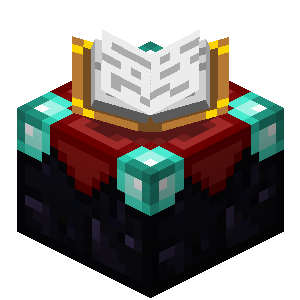
Since the official release of the game in November 2011, Minecraft has had many significant changes. One of the most important is the ability to enchant your equipment. The following short guide will introduce you to this addition and especially explain it to you so that you master the art of enchanting.
The necessary equipment
To enchant your equipment, you will need the following items:
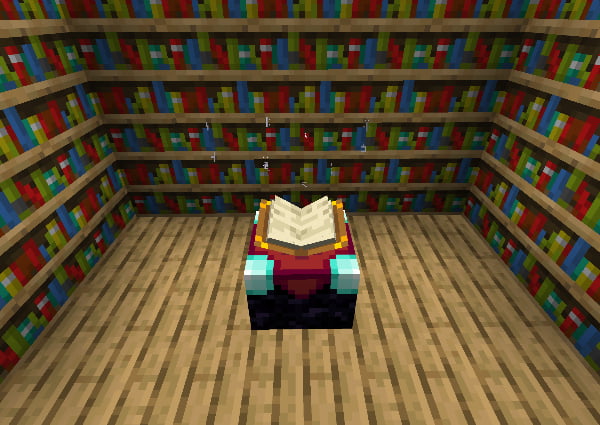
- enchantment table is used to enchant items, making it a vital block for enchanting.
- library: each library increases the level of enchantments.
- lapis lazuli: necessary to feed the table.
- Book: you can enchant a book and then apply its enchantment to another object via an anvil.
You can easily make libraries thanks to the villages. You will have to mine to find lapis lazuli and find books in the villages. You can follow the steps below if you don’t know how to make an enchantment table.
Enchanting methods
There are three ways to enchant an item in Survival mode:
- Via an enchantment table in exchange for experience points and lapis lazuli. Only unenchanted items can be enchanted this way.
- Via an anvil, by combining an enchanted book with an item.
- Via an anvil, by combining two items of the same type with different existing enchantments into one item that has the enchantments of both.
A player can also obtain already enchanted items:
- Via a villager, who can trade certain enchanted items for emeralds.
- Through fishing, which gives a chance to get enchanted items.
- Via a zombie, a drowning person, a mummified zombie, a skeleton, etc.: if they have enchanted items and the player kills them, he has an 8.5% chance of dropping each of the said items.
- Via the discovery of these items in End cities and other various treasure chests, such as wrecks, mine shafts, dungeons, desert temples, jungle temples, forest mansions, sea ruins, and fortresses.
- Kill raiders and vindicators in raids.
Server operators and players in singleplayer worlds where cheats are allowed can also enchant items using commands such as /enchant. When enchanted with the /give command, the maximum enchantment level is 2,147,483,647. In Creative mode, items can be enchanted via an anvil and enchanted books, requiring no experience points. Enchanted books are available in the Creative mode inventory, with individual book displays for the highest level of each enchantment and other levels available via the “Search” tab.
Using the enchantment table
An object can be enchanted by using an enchantment table and placing the object in the input boxes and 1-3 Lapis Lazuli in its dedicated box. Once the item is placed, three (pseudo) random options appear on the right side of the GUI. The glyphs here do not affect the enchantment, but hovering over an enchantment shown shows an enchantment to apply (on mobile devices, the player can tap on an enchantment before placing the lapis lazuli or hold the enchantment before releasing it). The only choices available have a level requirement equal to or less than the player’s current level and a lapis lazuli requirement equal to or less than the number of lapis lazuli placed in the table.
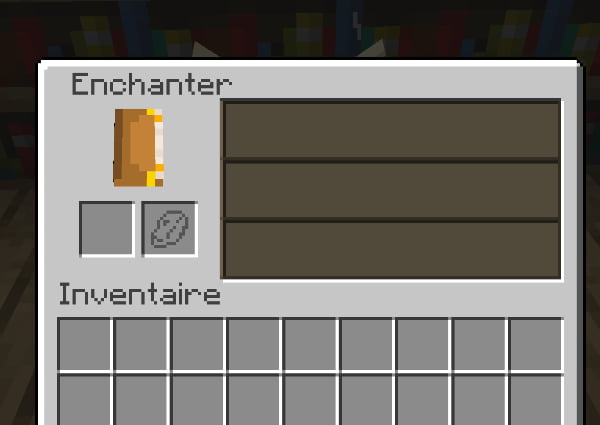
Each option has a set of random enchantments that depend on the number of experience levels required (for example, a level 10 enchantment may give a deck the “Efficiency II” enchantment); the actual cost of the level, and the number of lapis lazuli required to have no effect.
Although the player must have at least the required level to obtain an enchantment, the number of levels they must pay is the same as the number of lapis lazuli required. For example, if the third enchantment listed is a level 30-50 enchantment, the player must have at least 30 levels, pays only three and three lapis lazuli.
The level requirement influences the amount, type, and level of enchantments instilled in the item, with higher levels of experience generally resulting in more and higher-level enchantments. Nevertheless, there is a significant random factor. Even a level 30 enchantment (the maximum) does not guarantee more than one enchantment. Even that enchantments are “maximum strength” -a level 30 enchantment may still give Fortune II or Efficiency III alone.
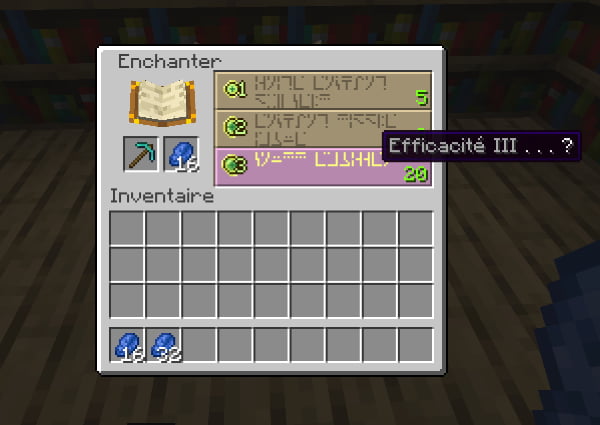
The shelves must be placed next to the enchantment table while keeping an air block between them to increase the enchantment level. To access the level 30 enchantments mentioned above, a total of 15 shelves must be placed around the enchantment table. See the enchantment mechanics page for more information on this topic.
Enchanting a book produces an enchanted book, which does nothing by itself, but effectively “saves” the enchantment for later application to another object with an anvil.
Unlike the anvil, using the enchantment table in Creative mode costs experience. However, if the player does not have enough experience, the expertise reduces to zero, and the enchantment still works, even when using the enchantment table while already at zero levels.
Changing the Enchantments Available
Enchanting an item at any enchantment level changes the player’s enchantment seed, which changes the possible enchantments for each item at each enchantment level. Thus, if none of the available enchantments for a tool are desired, 1 lapis lazuli and 1 level could be spent to enchant a different book or tool to refresh the list.
The possible enchantments depend on the player’s enchantment seed, the type of item and material, and the enchantment level (1-30). Removing the item and putting it back, clicking on another item’s slot, using another item of the same type and material, replacing or moving the table (but keeping the same number of bookcases), using another table with the same number of bookcases, or replacing or rearranging the bookcases without changing their total number does not affect the possible enchantments.
Changing the enchantment levels offered by adding, deleting, or blocking libraries change the enchantments shown but do not change the possible enchantments; using another enchantment table with the previous library number keeps the previous enchantments. The enchantments for a particular enchantment level (with the same seed and item) also differ depending on the row they appear. Still, they are not “better” or “worse,” depending on the row.
Using the anvil to combine enchantments
An anvil can be used to combine the enchantments of two objects, sacrificing one and repairing the other. The items must be compatible; they must either be of the same type and material (such as two iron swords) or an item and an enchanted book with an applicable enchantment (such as a bow and an enchanted book of infinity).
Combining two items, books, or one of each item with the same enchantment at the same level produces an item or book with the next higher level of that enchantment up to the maximum allowed in survival mode; for example, a book with Spines I and Strength II combined with a book with Strength II produces a book with Spines I and Strength III.
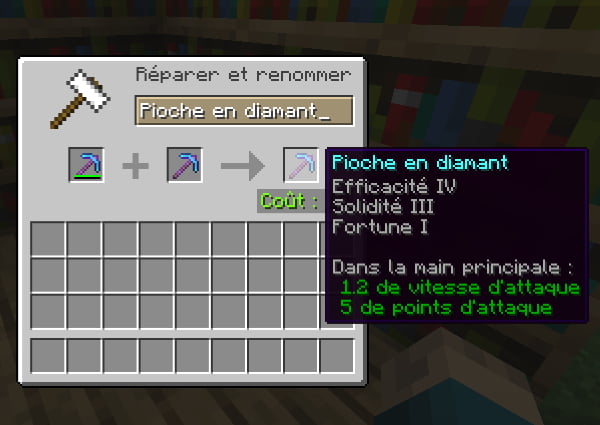
To combine items, the player places the target item in the first slot of the anvil and the sacrifice item in the second slot. If the combination is allowed, the resulting enchanted thing appears in the anvil’s output slot. An experience level cost called the “Enchant Cost” appears below it (green if the player has enough experience levels, red if not). The player removes the enchanted item from the anvil’s exit slot to complete the enchantment, and his experience level is reduced accordingly.
The cost of experience depends on the enchantments, with heavily enchanted items costing more. If the target object is also repaired, this also costs more. The target object can also be renamed, which costs extra. There is also a cumulative surcharge for previous work done on the anvil. In Survival Mode, jobs that cost more than 39 experience levels are disallowed, although it is still possible to do the same job in stages. For example, a damaged enchanted bow can be repaired on an anvil with an ordinary bow, and then another enchanted bow can be used to combine enchantments with the repaired bow.
Using an Enchanted Book
Enchanted books can be made by using an enchantment table to enchant book. (They can also be found in generated chests, purchased with emeralds from a bookstore in a village, or fished out of a fishing pole).
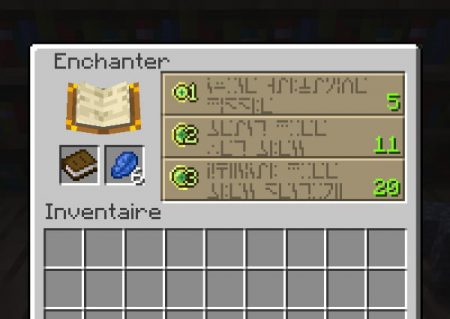
The book can receive several enchantments of any type, but only the enchantments appropriate for a given type of object can be applied to that object. For example, the same book can receive both Apnea and Power enchantments. Still, the Apnea enchantment is lost if the book is applied to any object other than a helmet, and the Power enchantment is lost if the book is applied to any object other than a bow.
Enchanted books are used on an anvil to add enchantments to objects, including other books. They can apply certain enchantments to objects that cannot be enchanted from an enchantment table, such as Thorn to boots.
In Creative mode, books can enchant any item with any enchantment, such as a staff with a Recoil II enchantment.
The experience costs of using books are considerably lower than combining items with similar enchantments since the books themselves cost levels to create. However, this is still an additional cost, and enchantment items directly have a chance to get multiple enchantments. The advantage of books is that they can be stored for use on an item of choice and allow controlled combinations.
For example, a book with Silk Touch can be used on an ax, a pickaxe, or a shovel, and the player can decide which item gets which enchantment.
Disenchanting an object
The only way to disenchant items is to use the grinding wheel or to repair it. Using the grinding wheel removes all enchantments (except the Curse of Binding and the Curse of Vanishing) and gives experience back according to the enchantment level (s) and their value.
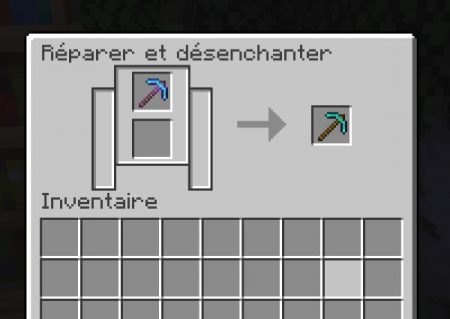
List of Enchantments
Each enchantment in the table below includes attributes that the player can legitimately acquire in Survival Mode. Other combinations are possible in Creative mode or with cheats, mods, or third-party software.
| Name | Summary |
|---|---|
| Aqua Affinity | Removes the slowdown of underwater mining. |
| Bane of Arthropods | Increases damage and applies Slowness IV to arthropod mobs (spiders, cave spiders, silverfish, endermites, and bees). |
| Blast Protection | Reduces explosion damage and knockback. |
| Channeling | Trident “channels” a bolt of lightning toward a hit entity. Functions only during thunderstorms and if the target is unobstructed with opaque blocks. |
| Cleaving | Increases damage and shield stunning. |
| Curse of Binding | Items cannot be removed from armor slots, except in Creative mode or due to death or breaking. |
| Curse of Vanishing | Item destroyed on death. |
| Depth Strider | Increases underwater movement speed. |
| Efficiency | Increases mining speed. When applied to an Axe, it increases the chance that the ax may stun a shield, with the base chance being 25% and a 5% increase for each efficiency level. |
| Feather Falling | Reduces fall damage. |
| Fire Aspect | Sets target on fire. |
| Fire Protection | Reduces fire damage and burn time. Mutually exclusive with other protections. |
| Flame | Arrows set the target on fire and ignite TNT if hit. |
| Fortune | Increases certain block drops. Higher levels increase chances. |
| Frost Walker | It turns to water beneath the player into frosted ice and prevents the damage the player would take from standing on magma blocks. |
| Impaling | Trident deals additional damage to mobs that spawn naturally in the ocean. In Bedrock Edition, having impaling on a trident also deals extra damage to players or mobs in water or rain. |
| Infinity | Shooting consumes no regular arrows. Does not include Tipped Arrows or Spectral Arrows. |
| Knockback | Increases knockback. |
| Looting | Increases mob loot. Higher levels increase loot dropped. |
| Loyalty | Trident returns after being thrown. Higher levels reduce return time. |
| Luck of the Sea | Increases rate of good loot (enchanting books, etc.). Higher Levels Increase chance. |
| Lure | Decreases wait time until fish/junk/loot “bites.” Higher Levels increase speed. |
| Mending | Repair the item while gaining XP orbs. |
| Multishot | Shoot 3 arrows at the cost of one; only one arrow can be recovered. |
| Piercing | Arrows pass through multiple entities. Only available to the Crossbow. |
| Power | Increases arrow damage. |
| Projectile Protection | Reduces projectile damage such as damage from arrows, thrown tridents, ghast and blaze fireballs, etc. |
| Protection | Reduces most types of damage by 4%[JE only] or 5%[BE only] for each level. |
| Punch | Increases arrow knockback. |
| Quick Charge | Decreases crossbow charging time. |
| Respiration | Extends underwater breathing time. Stacks with a Turtle Shell |
| Riptide | Trident launches player with itself when thrown. Functions only in water or rain. |
| Sharpness | Increases damage for melee weapons. |
| Silk Touch | Mined blocks drop themselves, with a few exceptions. |
| Smite | Increases damage to undead mobs. |
| Soul Speed | Increases walking speed on soul sand or Soul Soil but damage the Boots over time. |
| Sweeping Edge | Increases sweeping attack damage. |
| Thorns | Reflects some of the damage taken when hit, at the cost of reducing durability with each proc. |
| Unbreaking | Reduces the chance of an item taking damage. Higher levels decrease the possibility further. |
List of the best enchantments by items
- List of the best enchantments for the sword
- List of the best enchantments for the bow
- List of the best enchantments for the helmet
- List of the best enchantments for the breastplate
- List of the best enchantments for the leggings
- List of the best enchantments for the boots
- List of the best enchantments for the trident
Originally posted 2021-11-11 13:24:16.